Abstract
Irradiation with ultraviolet B light (UVB) is known to suppress contact and delayed hypersensitivity response to a variety of antigens encountered within a short period following exposure. Such irradiation results in loss of Langerhans' cells and in synthesis of tumour necrosis factor-alpha (TNF-alpha) in the epidermis. In the present study the effect of broad-band (270-350 nm) and narrow-band (311-312 nm) UVB on the induction of contact hypersensitivity (CH) and on dendritic cell (DC) numbers in draining lymph nodes (DLN) of mice was examined. Broad-band UVB induced the accumulation of DC in DLN and this increase was substantially abrogated by treatment of mice with neutralizing antibody to TNF-alpha before irradiation. In addition, irradiation before sensitization with oxazolone resulted in a suppressed CH response. The suppression was negated to a considerable extent by TNF-alpha antibodies, administered before irradiation. Thus, one of the major effects of broad-band UVB is likely to be the synthesis of epidermal TNF-alpha which, in turn induces the migration of Langerhans' cells to DLN and leads to an impairment of their activity or function. Conversely narrow-band UVB did not result in an accumulation of DC in DLN or in a suppressed CH response. Such irradiation does, however, cause the isomerization from trans to cis-UCA in the epidermis. Cis-UCA has been proposed as a photoreceptor for UV and suppresses immune responses in a variety of experimental systems. Thus cis-UCA does not act through TNF-alpha induction or by influencing DC migration, and other studies indicate that histamine-like receptors in the skin may be involved.
Full text
PDF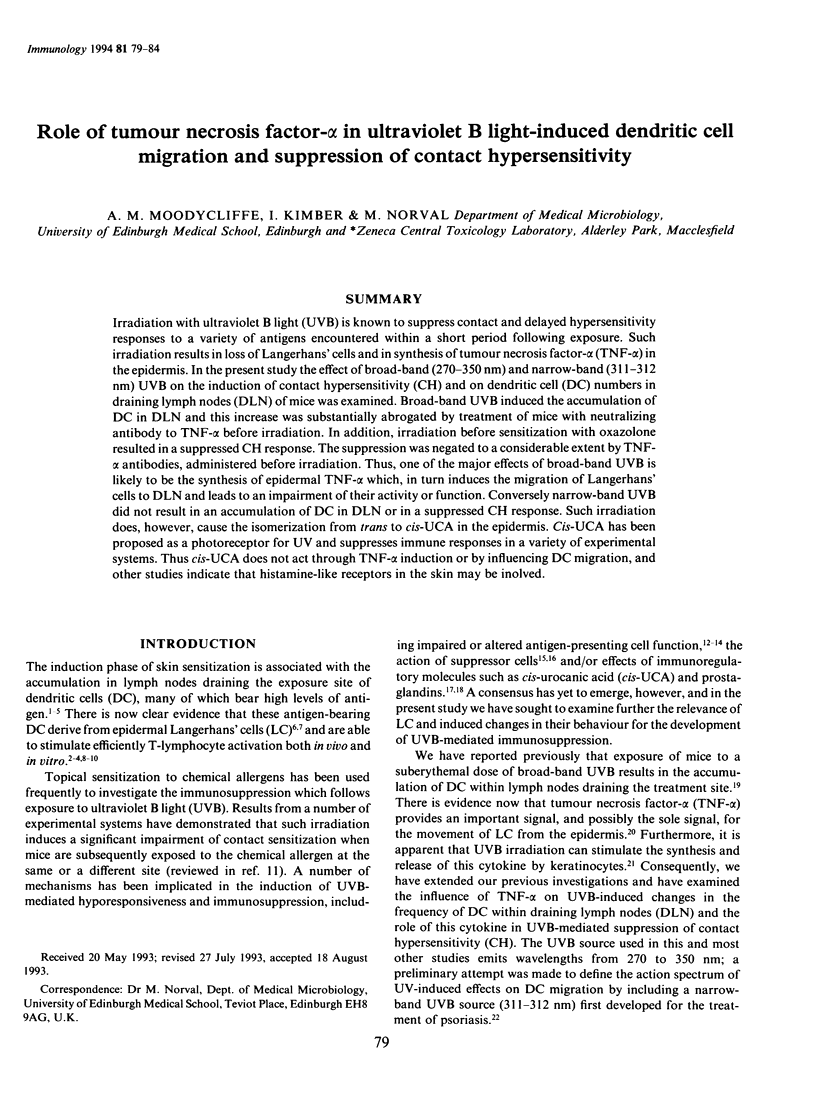
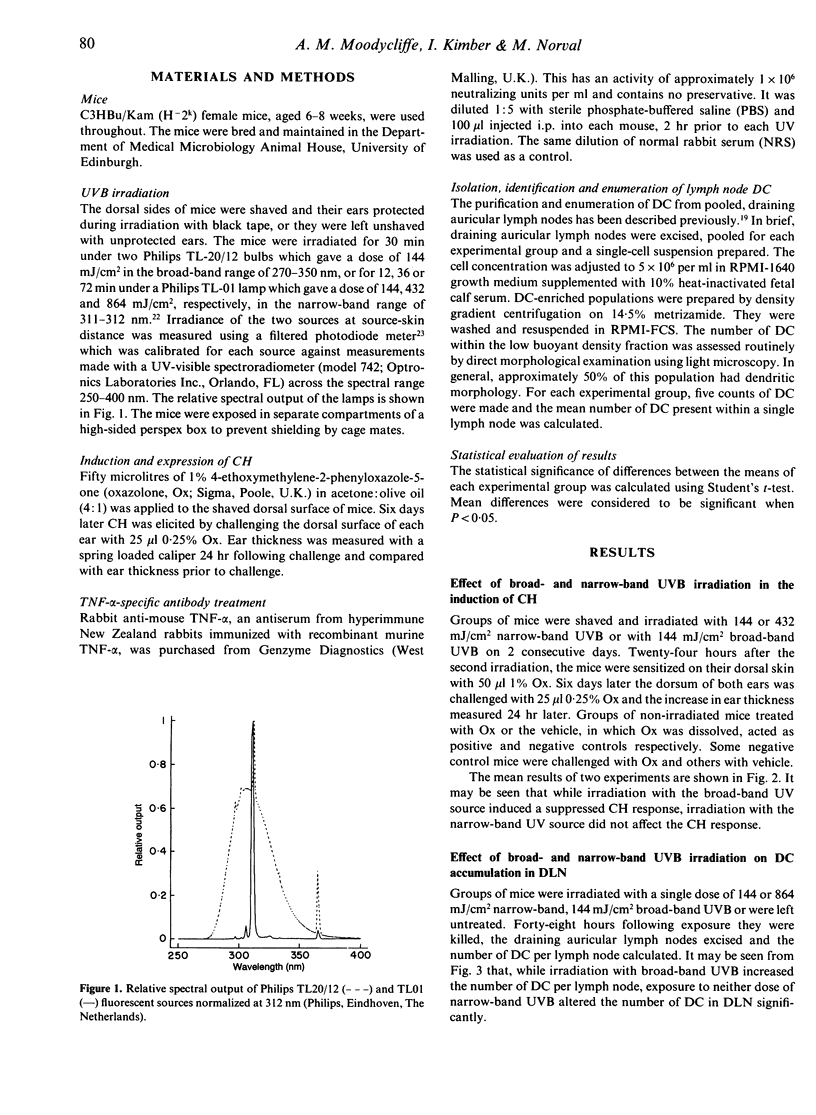
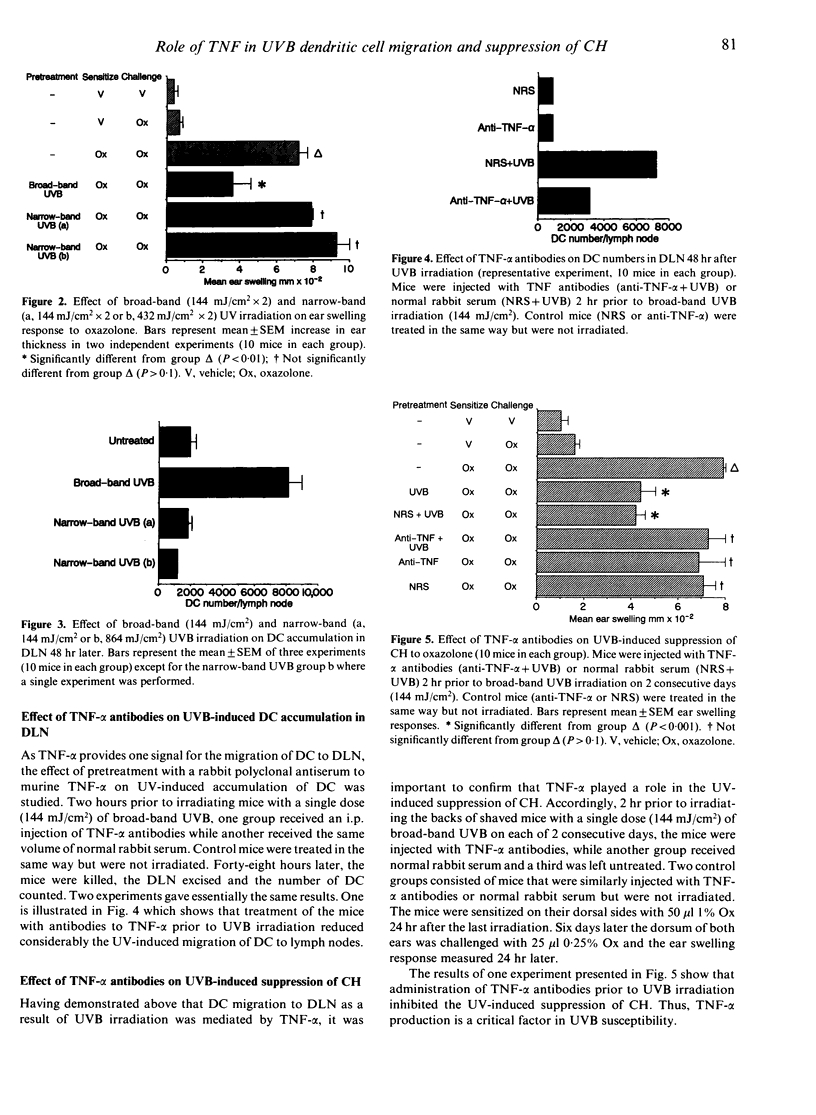
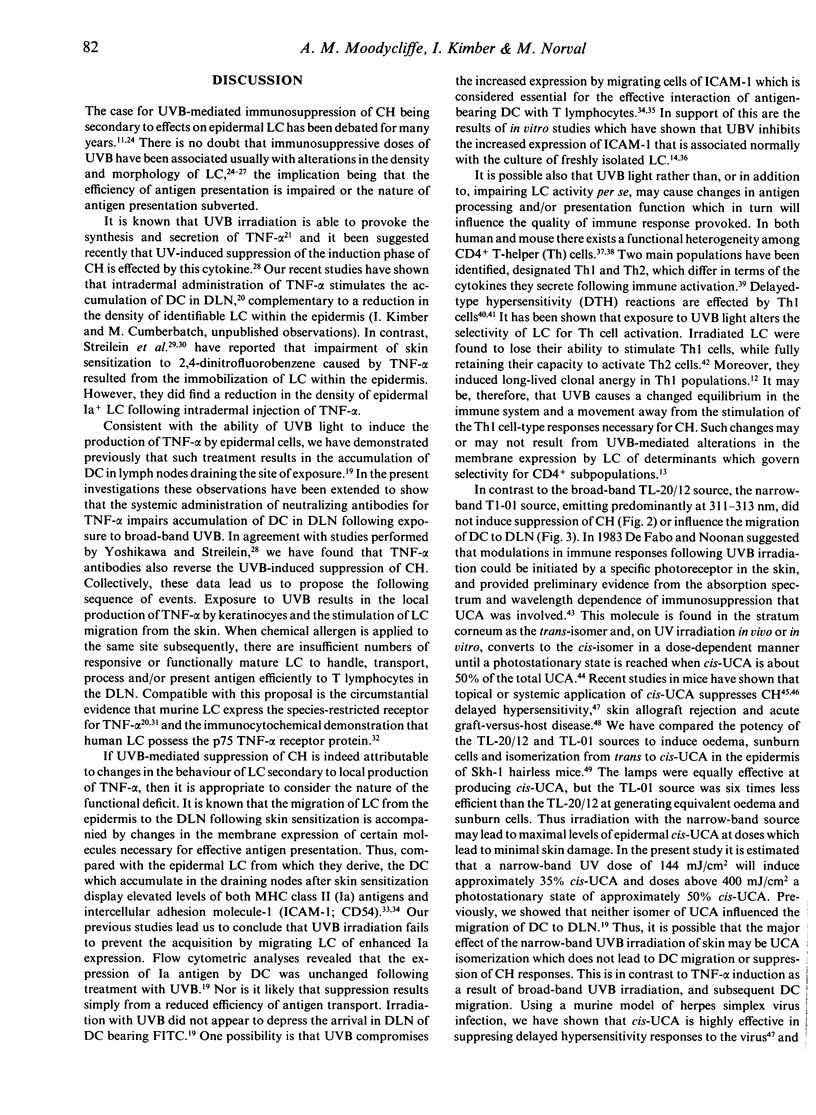
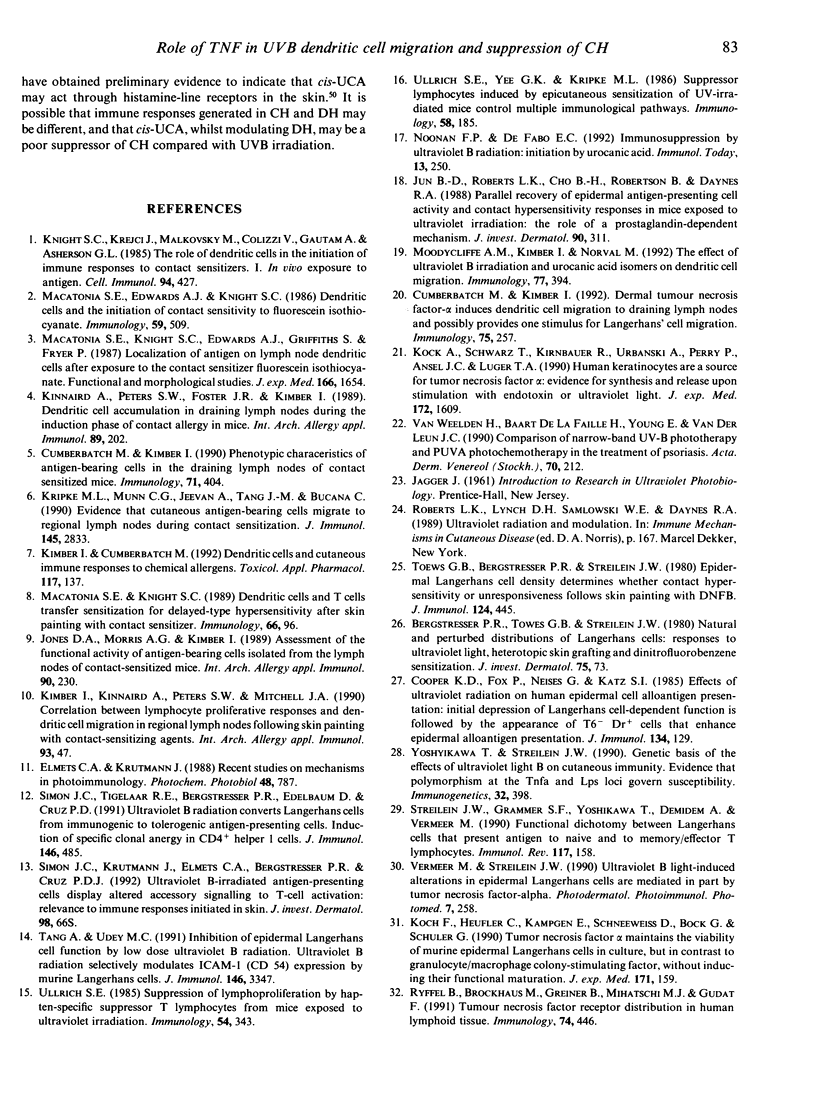
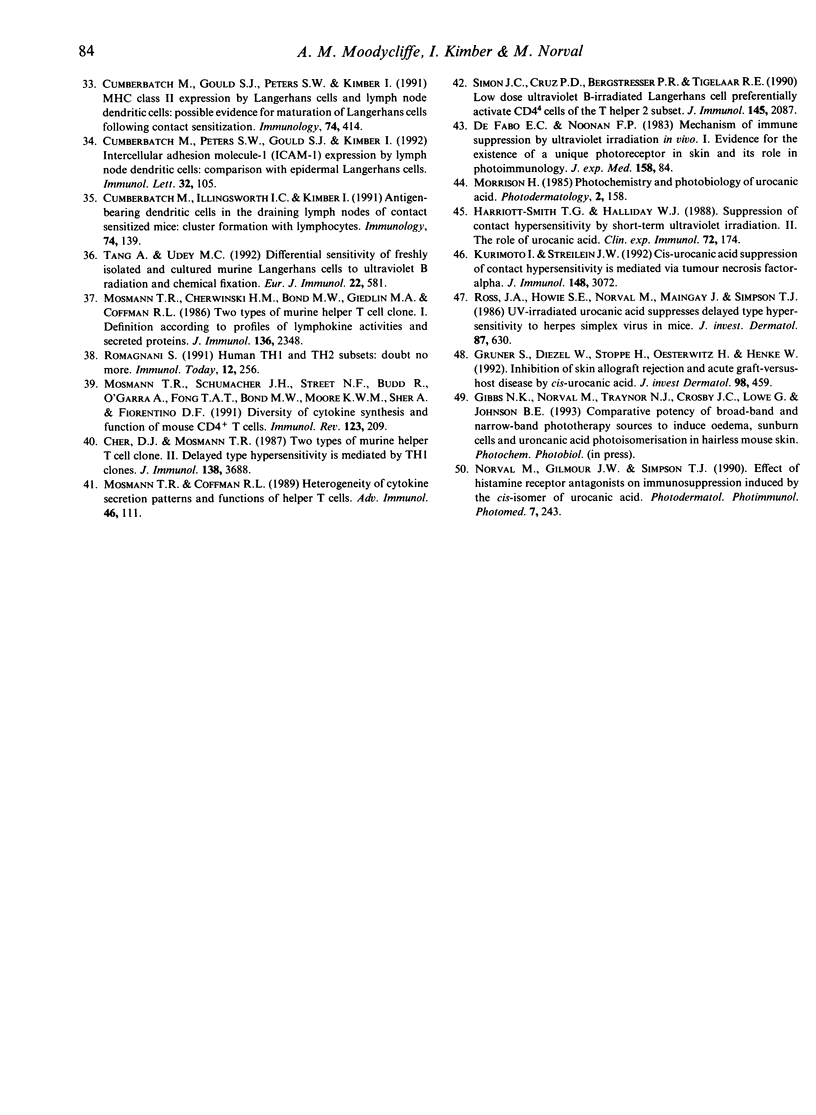
Selected References
These references are in PubMed. This may not be the complete list of references from this article.
- Cher D. J., Mosmann T. R. Two types of murine helper T cell clone. II. Delayed-type hypersensitivity is mediated by TH1 clones. J Immunol. 1987 Jun 1;138(11):3688–3694. [PubMed] [Google Scholar]
- Cooper K. D., Fox P., Neises G., Katz S. I. Effects of ultraviolet radiation on human epidermal cell alloantigen presentation: initial depression of Langerhans cell-dependent function is followed by the appearance of T6- Dr+ cells that enhance epidermal alloantigen presentation. J Immunol. 1985 Jan;134(1):129–137. [PubMed] [Google Scholar]
- Cumberbatch M., Gould S. J., Peters S. W., Kimber I. MHC class II expression by Langerhans' cells and lymph node dendritic cells: possible evidence for maturation of Langerhans' cells following contact sensitization. Immunology. 1991 Nov;74(3):414–419. [PMC free article] [PubMed] [Google Scholar]
- Cumberbatch M., Illingworth I., Kimber I. Antigen-bearing dendritic cells in the draining lymph nodes of contact sensitized mice: cluster formation with lymphocytes. Immunology. 1991 Sep;74(1):139–145. [PMC free article] [PubMed] [Google Scholar]
- Cumberbatch M., Kimber I. Dermal tumour necrosis factor-alpha induces dendritic cell migration to draining lymph nodes, and possibly provides one stimulus for Langerhans' cell migration. Immunology. 1992 Feb;75(2):257–263. [PMC free article] [PubMed] [Google Scholar]
- Cumberbatch M., Kimber I. Phenotypic characteristics of antigen-bearing cells in the draining lymph nodes of contact sensitized mice. Immunology. 1990 Nov;71(3):404–410. [PMC free article] [PubMed] [Google Scholar]
- Cumberbatch M., Peters S. W., Gould S. J., Kimber I. Intercellular adhesion molecule-1 (ICAM-1) expression by lymph node dendritic cells: comparison with epidermal Langerhans cells. Immunol Lett. 1992 Apr;32(2):105–110. doi: 10.1016/0165-2478(92)90101-s. [DOI] [PubMed] [Google Scholar]
- De Fabo E. C., Noonan F. P. Mechanism of immune suppression by ultraviolet irradiation in vivo. I. Evidence for the existence of a unique photoreceptor in skin and its role in photoimmunology. J Exp Med. 1983 Jul 1;158(1):84–98. doi: 10.1084/jem.158.1.84. [DOI] [PMC free article] [PubMed] [Google Scholar]
- Gruner S., Diezel W., Stoppe H., Oesterwitz H., Henke W. Inhibition of skin allograft rejection and acute graft-versus-host disease by cis-urocanic acid. J Invest Dermatol. 1992 Apr;98(4):459–462. doi: 10.1111/1523-1747.ep12499855. [DOI] [PubMed] [Google Scholar]
- Harriott-Smith T. G., Halliday W. J. Suppression of contact hypersensitivity by short-term ultraviolet irradiation: II. The role of urocanic acid. Clin Exp Immunol. 1988 Apr;72(1):174–177. [PMC free article] [PubMed] [Google Scholar]
- Jones D. A., Morris A. G., Kimber I. Assessment of the functional activity of antigen-bearing dendritic cells isolated from the lymph nodes of contact-sensitized mice. Int Arch Allergy Appl Immunol. 1989;90(3):230–236. doi: 10.1159/000235030. [DOI] [PubMed] [Google Scholar]
- Kimber I., Cumberbatch M. Dendritic cells and cutaneous immune responses to chemical allergens. Toxicol Appl Pharmacol. 1992 Dec;117(2):137–146. doi: 10.1016/0041-008x(92)90230-p. [DOI] [PubMed] [Google Scholar]
- Kimber I., Kinnaird A., Peters S. W., Mitchell J. A. Correlation between lymphocyte proliferative responses and dendritic cell migration in regional lymph nodes following skin painting with contact-sensitizing agents. Int Arch Allergy Appl Immunol. 1990;93(1):47–53. doi: 10.1159/000235278. [DOI] [PubMed] [Google Scholar]
- Kinnaird A., Peters S. W., Foster J. R., Kimber I. Dendritic cell accumulation in draining lymph nodes during the induction phase of contact allergy in mice. Int Arch Allergy Appl Immunol. 1989;89(2-3):202–210. doi: 10.1159/000234947. [DOI] [PubMed] [Google Scholar]
- Knight S. C., Krejci J., Malkovsky M., Colizzi V., Gautam A., Asherson G. L. The role of dendritic cells in the initiation of immune responses to contact sensitizers. I. In vivo exposure to antigen. Cell Immunol. 1985 Sep;94(2):427–434. doi: 10.1016/0008-8749(85)90266-7. [DOI] [PubMed] [Google Scholar]
- Koch F., Heufler C., Kämpgen E., Schneeweiss D., Böck G., Schuler G. Tumor necrosis factor alpha maintains the viability of murine epidermal Langerhans cells in culture, but in contrast to granulocyte/macrophage colony-stimulating factor, without inducing their functional maturation. J Exp Med. 1990 Jan 1;171(1):159–171. doi: 10.1084/jem.171.1.159. [DOI] [PMC free article] [PubMed] [Google Scholar]
- Kripke M. L., Munn C. G., Jeevan A., Tang J. M., Bucana C. Evidence that cutaneous antigen-presenting cells migrate to regional lymph nodes during contact sensitization. J Immunol. 1990 Nov 1;145(9):2833–2838. [PubMed] [Google Scholar]
- Krutmann J., Elmets C. A. Recent studies on mechanisms in photoimmunology. Photochem Photobiol. 1988 Dec;48(6):787–798. doi: 10.1111/j.1751-1097.1988.tb02894.x. [DOI] [PubMed] [Google Scholar]
- Kurimoto I., Streilein J. W. cis-urocanic acid suppression of contact hypersensitivity induction is mediated via tumor necrosis factor-alpha. J Immunol. 1992 May 15;148(10):3072–3078. [PubMed] [Google Scholar]
- Köck A., Schwarz T., Kirnbauer R., Urbanski A., Perry P., Ansel J. C., Luger T. A. Human keratinocytes are a source for tumor necrosis factor alpha: evidence for synthesis and release upon stimulation with endotoxin or ultraviolet light. J Exp Med. 1990 Dec 1;172(6):1609–1614. doi: 10.1084/jem.172.6.1609. [DOI] [PMC free article] [PubMed] [Google Scholar]
- Macatonia S. E., Edwards A. J., Knight S. C. Dendritic cells and the initiation of contact sensitivity to fluorescein isothiocyanate. Immunology. 1986 Dec;59(4):509–514. [PMC free article] [PubMed] [Google Scholar]
- Macatonia S. E., Knight S. C. Dendritic cells and T cells transfer sensitization for delayed-type hypersensitivity after skin painting with contact sensitizer. Immunology. 1989 Jan;66(1):96–99. [PMC free article] [PubMed] [Google Scholar]
- Macatonia S. E., Knight S. C., Edwards A. J., Griffiths S., Fryer P. Localization of antigen on lymph node dendritic cells after exposure to the contact sensitizer fluorescein isothiocyanate. Functional and morphological studies. J Exp Med. 1987 Dec 1;166(6):1654–1667. doi: 10.1084/jem.166.6.1654. [DOI] [PMC free article] [PubMed] [Google Scholar]
- Moodycliffe A. M., Kimber I., Norval M. The effect of ultraviolet B irradiation and urocanic acid isomers on dendritic cell migration. Immunology. 1992 Nov;77(3):394–399. [PMC free article] [PubMed] [Google Scholar]
- Morrison H. Photochemistry and photobiology of urocanic acid. Photodermatol. 1985 Jun;2(3):158–165. [PubMed] [Google Scholar]
- Mosmann T. R., Cherwinski H., Bond M. W., Giedlin M. A., Coffman R. L. Two types of murine helper T cell clone. I. Definition according to profiles of lymphokine activities and secreted proteins. J Immunol. 1986 Apr 1;136(7):2348–2357. [PubMed] [Google Scholar]
- Mosmann T. R., Coffman R. L. Heterogeneity of cytokine secretion patterns and functions of helper T cells. Adv Immunol. 1989;46:111–147. doi: 10.1016/s0065-2776(08)60652-5. [DOI] [PubMed] [Google Scholar]
- Mosmann T. R., Schumacher J. H., Street N. F., Budd R., O'Garra A., Fong T. A., Bond M. W., Moore K. W., Sher A., Fiorentino D. F. Diversity of cytokine synthesis and function of mouse CD4+ T cells. Immunol Rev. 1991 Oct;123:209–229. doi: 10.1111/j.1600-065x.1991.tb00612.x. [DOI] [PubMed] [Google Scholar]
- Noonan F. P., De Fabo E. C. Immunosuppression by ultraviolet B radiation: initiation by urocanic acid. Immunol Today. 1992 Jul;13(7):250–254. doi: 10.1016/0167-5699(92)90005-R. [DOI] [PubMed] [Google Scholar]
- Norval M., Gilmour J. W., Simpson T. J. The effect of histamine receptor antagonists on immunosuppression induced by the cis-isomer of urocanic acid. Photodermatol Photoimmunol Photomed. 1990 Dec;7(6):243–248. [PubMed] [Google Scholar]
- Roberts L. K., Lynch D. H., Samlowski W. E., Daynes R. A. Ultraviolet radiation and modulation. Immunol Ser. 1989;46:167–215. [PubMed] [Google Scholar]
- Romagnani S. Human TH1 and TH2 subsets: doubt no more. Immunol Today. 1991 Aug;12(8):256–257. doi: 10.1016/0167-5699(91)90120-I. [DOI] [PubMed] [Google Scholar]
- Ross J. A., Howie S. E., Norval M., Maingay J., Simpson T. J. Ultraviolet-irradiated urocanic acid suppresses delayed-type hypersensitivity to herpes simplex virus in mice. J Invest Dermatol. 1986 Nov;87(5):630–633. doi: 10.1111/1523-1747.ep12456257. [DOI] [PubMed] [Google Scholar]
- Ryffel B., Brockhaus M., Greiner B., Mihatsch M. J., Gudat F. Tumour necrosis factor receptor distribution in human lymphoid tissue. Immunology. 1991 Nov;74(3):446–452. [PMC free article] [PubMed] [Google Scholar]
- Simon J. C., Cruz P. D., Jr, Bergstresser P. R., Tigelaar R. E. Low dose ultraviolet B-irradiated Langerhans cells preferentially activate CD4+ cells of the T helper 2 subset. J Immunol. 1990 Oct 1;145(7):2087–2091. [PubMed] [Google Scholar]
- Simon J. C., Krutmann J., Elmets C. A., Bergstresser P. R., Cruz P. D., Jr Ultraviolet B-irradiated antigen-presenting cells display altered accessory signaling for T-cell activation: relevance to immune responses initiated in skin. J Invest Dermatol. 1992 Jun;98(6 Suppl):66S–69S. doi: 10.1111/1523-1747.ep12462236. [DOI] [PubMed] [Google Scholar]
- Simon J. C., Tigelaar R. E., Bergstresser P. R., Edelbaum D., Cruz P. D., Jr Ultraviolet B radiation converts Langerhans cells from immunogenic to tolerogenic antigen-presenting cells. Induction of specific clonal anergy in CD4+ T helper 1 cells. J Immunol. 1991 Jan 15;146(2):485–491. [PubMed] [Google Scholar]
- Tang A., Udey M. C. Differential sensitivity of freshly isolated and cultured murine Langerhans cells to ultraviolet B radiation and chemical fixation. Eur J Immunol. 1992 Feb;22(2):581–586. doi: 10.1002/eji.1830220242. [DOI] [PubMed] [Google Scholar]
- Tang A., Udey M. C. Inhibition of epidermal Langerhans cell function by low dose ultraviolet B radiation. Ultraviolet B radiation selectively modulates ICAM-1 (CD54) expression by murine Langerhans cells. J Immunol. 1991 May 15;146(10):3347–3355. [PubMed] [Google Scholar]
- Toews G. B., Bergstresser P. R., Streilein J. W. Epidermal Langerhans cell density determines whether contact hypersensitivity or unresponsiveness follows skin painting with DNFB. J Immunol. 1980 Jan;124(1):445–453. [PubMed] [Google Scholar]
- Ullrich S. E. Suppression of lymphoproliferation by hapten-specific suppressor T lymphocytes from mice exposed to ultraviolet radiation. Immunology. 1985 Feb;54(2):343–352. [PMC free article] [PubMed] [Google Scholar]
- Ullrich S. E., Yee G. K., Kripke M. L. Suppressor lymphocytes induced by epicutaneous sensitization of UV-irradiated mice control multiple immunological pathways. Immunology. 1986 Jun;58(2):185–190. [PMC free article] [PubMed] [Google Scholar]
- Van Weelden H., Baart de la Faille H., Young E., van der Leun J. C. Comparison of narrow-band UV-B phototherapy and PUVA photochemotherapy in the treatment of psoriasis. Acta Derm Venereol. 1990;70(3):212–215. [PubMed] [Google Scholar]
- Vermeer M., Streilein J. W. Ultraviolet B light-induced alterations in epidermal Langerhans cells are mediated in part by tumor necrosis factor-alpha. Photodermatol Photoimmunol Photomed. 1990 Dec;7(6):258–265. [PubMed] [Google Scholar]
- Yoshikawa T., Streilein J. W. Genetic basis of the effects of ultraviolet light B on cutaneous immunity. Evidence that polymorphism at the Tnfa and Lps loci governs susceptibility. Immunogenetics. 1990;32(6):398–405. doi: 10.1007/BF00241633. [DOI] [PubMed] [Google Scholar]


